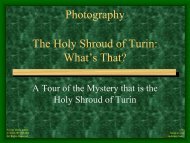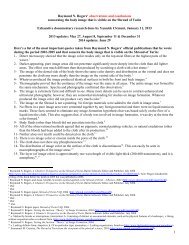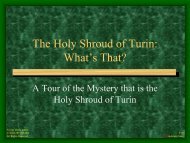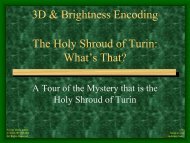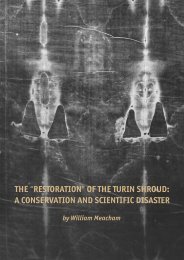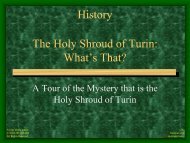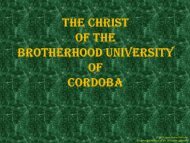Turin Shroud Presentation: Crucifixion - ShroudNM.com
Turin Shroud Presentation: Crucifixion - ShroudNM.com
Turin Shroud Presentation: Crucifixion - ShroudNM.com
Create successful ePaper yourself
Turn your PDF publications into a flip-book with our unique Google optimized e-Paper software.
<strong>Crucifixion</strong><br />
The Holy <strong>Shroud</strong> of <strong>Turin</strong>:<br />
What’s That?<br />
A Tour of the Mystery that is the<br />
Holy <strong>Shroud</strong> of <strong>Turin</strong><br />
Except where noted,<br />
© 2010-2015 SEAM<br />
All Rights Reserved<br />
v19<br />
Menu at end<br />
Red indicates links
Back (Dorsal) Image<br />
<strong>Crucifixion</strong><br />
Image of a Crucified Man<br />
Upper Back<br />
© 1978 Barrie M. Schwortz<br />
Collection, STERA, Inc.<br />
Front (Ventral) Image<br />
L<br />
Feet<br />
Lower Legs<br />
Upper Legs<br />
Lower Back<br />
Hair<br />
Pony Tail<br />
Head<br />
Feet<br />
Chest Arms<br />
Upper Legs Knees<br />
Lower Legs R<br />
How do we know he was crucified? – continue for an examination<br />
R L L R<br />
© 1978 Barrie M. Schwortz<br />
Collection, STERA, Inc.<br />
© 1978 Barrie M. Schwortz<br />
Collection, STERA, Inc.<br />
1978 Schwortz Black & White Images<br />
2
<strong>Crucifixion</strong><br />
How can one be sure this is an image of a crucified man? 1 of 7<br />
Evidence Point 1 – Hand/wrist wounds reveal:<br />
• Consistent with crucifixion (wound location proved to hold up a<br />
crucified body)<br />
• Blood flow down both arms indicates:<br />
A nail went through each wrist & arms were up in crucifixion<br />
at that time, arms between a 65-68 ◦ angle for the blood flows 1<br />
Thumb either drawn into the palm due to the severing of the<br />
median nerve 10 or would be out of sight because it was at rest 2<br />
Blood<br />
Flow<br />
L<br />
Point 1<br />
Hand wounds<br />
R<br />
© 1978 Barrie M. Schwortz<br />
Collection, STERA, Inc.<br />
3
<strong>Crucifixion</strong><br />
Hand/Wrist Wounds<br />
• Wounds in the hands with thumbs not visible<br />
• Dr. Barbet surmises cause by puncturing the median nerve 1<br />
• Dr. Soons supports Dr. Zugibe 2 thumb at rest not be visible<br />
© 1978 Barrie M. Schwortz<br />
Collection, STERA, Inc.<br />
Note the hand<br />
wound reverse<br />
from positive<br />
to photo-negative<br />
© 1978 Barrie M. Schwortz<br />
Collection, STERA, Inc.<br />
L R R L<br />
• Blood flow down the arms indicates the arms were raised<br />
• One wound visible, blood flow proves both hands wounded<br />
• Arms clearly not broken<br />
4
<strong>Crucifixion</strong><br />
How can one be sure this is an image of a crucified man? #2 of 7<br />
Evidence Point 2 – Lance wound in the right side<br />
• Wound proved Jesus was upright & dead on cross; eyewitness<br />
records “blood and water flowed out” (Jn 19:31–37)<br />
• The “water” is pericardial fluid 1<br />
• Bilirubin mixed with blood fluoresced in the 1978 STURP<br />
investigation<br />
• Back blood flow called “belt of blood” 13<br />
Point 2<br />
Lance wound<br />
L<br />
Point 2<br />
Lance wound<br />
Post-<br />
Mortem<br />
Blood Flow<br />
R<br />
Blood<br />
Flow<br />
© 1978 Barrie M. Schwortz<br />
Collection, STERA, Inc.<br />
5
<strong>Crucifixion</strong><br />
Lance Wound<br />
• Blood from a lance in side proved death/very near death 2<br />
• Blood flow from lance wound toward the feet<br />
• Victim was upright when pierced<br />
L<br />
R<br />
L<br />
R<br />
Picture (Left)<br />
Computer reversal of left image on right<br />
6
<strong>Crucifixion</strong><br />
Lance Wound<br />
• Blood flow across the back from the lance wound<br />
• Known as the “belt of blood” 13<br />
R<br />
© 1978 Barrie M. Schwortz<br />
Collection, STERA, Inc.<br />
L<br />
R<br />
© 1978 Barrie M. Schwortz<br />
Collection, STERA, Inc.<br />
L<br />
These blood flows occurred after the man died (post-mortem) and the body was laid on the <strong>Shroud</strong><br />
7
<strong>Crucifixion</strong><br />
How can one be sure this is an image of a crucified man? #3 of 7<br />
Evidence Point 3 – Crown of thorns<br />
• No record of any crucifixion victim crowned with thorns<br />
• Except for one man – Jesus as recorded by an eyewitness (Jn<br />
19:2) as they mocked him (Jn 19:3) for being called King of the<br />
Jews (Jn 19:19-22; Mk 16:16-20)<br />
L<br />
Point 3<br />
Crown of thorns<br />
R<br />
Blood<br />
Flow<br />
Blood<br />
Flow<br />
© 1978 Barrie M. Schwortz<br />
Collection, STERA, Inc.<br />
8
<strong>Crucifixion</strong><br />
Head Wounds: Consistent with a Crown of Thorns<br />
R<br />
© 2010 Petrus Soons<br />
All Rights Reserved<br />
L<br />
• Holograms provide unique perspective 16<br />
On 2D photographs a bloodspot<br />
appears to be floating above the area<br />
of the head<br />
The holograms clarified that this<br />
BLOODSPOT was actually ON TOP<br />
OF THE HEAD<br />
There are more bloodspots all around<br />
the head area<br />
This indicates the crown of thorns<br />
was more helmet-like than circular<br />
9
<strong>Crucifixion</strong><br />
Head Wounds: Consistent with a Crown of Thorns<br />
The only record of any crucifixion victim being wounded in the head<br />
L<br />
Lower Back of Head Upper Back of Head Water stain Upper Front of Head<br />
Note: This image is in proper proportion<br />
Hair<br />
Forehead<br />
Beard<br />
R<br />
Crown of thorns wounds on the<br />
back of his head from the lower<br />
to the upper parts indicated by<br />
the blood left behind<br />
Crown of thorns wounds blood shown in white<br />
Blood reflects wounds around the scalp including the top<br />
Blood stands out with <strong>com</strong>puter reversals & enhancements<br />
Hair<br />
Tip of Nose<br />
Mustache<br />
Lips/<br />
Mouth<br />
Computer reversed & enhanced negative without removing colors, processed to enhance<br />
10
<strong>Crucifixion</strong><br />
Head Wounds: Consistent with a Crown of Thorns<br />
The only record of any crucifixion victim being wounded in the head<br />
L<br />
Lower Back of Head Upper Back of Head Water stain<br />
Upper Front of Head<br />
Note: Image is in proper proportion<br />
Hair<br />
Forehead<br />
Beard<br />
R<br />
Crown of thorns wounds on the<br />
back of his head from the lower<br />
to the upper parts indicated by<br />
the blood left behind<br />
Crown of thorns wounds blood shown in white<br />
Blood reflects wounds around the scalp including the top<br />
Blood stands out with <strong>com</strong>puter reversals & enhancements<br />
Hair<br />
Tip of Nose<br />
Mustache<br />
Lips/<br />
Mouth<br />
Computer reversed & enhanced image from previous slide<br />
11
<strong>Crucifixion</strong><br />
The water stain seems to distort<br />
and/or highlight the blood from the<br />
top of the head<br />
L<br />
Head Wounds: Consistent with a Crown of Thorns<br />
R<br />
Blood throughout hair and upper head<br />
Blood on the tip of the nose<br />
Blood on the cheek<br />
Blood in the hair<br />
Blood in the mustache & beard<br />
This image done with a filter to highlight the AB human blood in red<br />
12
Inversed<br />
<strong>Crucifixion</strong><br />
Head Wounds: Consistent with a Crown of Thorns<br />
• Puncture wounds caused by a crown or cap of thorns<br />
• This was proven by the holographic 3D work of Dr. Petrus Soons 10<br />
• This is the only extant example of wounding the head during a crucifixion<br />
• Eyewitness account of Jesus’ crucifixion reports crown of thorns<br />
L R L R<br />
Positive<br />
2011 Weiss<br />
Enhanced Contrast<br />
© 1978 Barrie M. Schwortz<br />
Collection, STERA, Inc.<br />
2011 Weiss<br />
Enhanced Contrast<br />
© 1978 Barrie M. Schwortz<br />
Collection, STERA, Inc.<br />
Image Enhanced Color Photo (L) showing blood in red/black & Inversed Colors (R) showing blood in bluish/greenish-white<br />
13
© 1978 Barrie M. Schwortz<br />
Collection, STERA, Inc.<br />
R<br />
<strong>Turin</strong> <strong>Shroud</strong> photographic negative facial image with bloodstains in red,<br />
image flipped left to right<br />
<strong>Crucifixion</strong><br />
Head Wounds: Consistent with a Crown of Thorns<br />
L<br />
• Unique edited photo by<br />
Barrie Schwortz highlighting<br />
the blood on a negative<br />
photo of the <strong>Shroud</strong> face<br />
• Puncture wounds caused by<br />
a crown or cap of thorns<br />
• This was proven by the<br />
holographic 3D work of Dr.<br />
Petrus Soons 10<br />
• This is the only extant<br />
example of wounding the<br />
head during a crucifixion<br />
• Eyewitness account of Jesus’<br />
crucifixion reports crown of<br />
thorns<br />
14
<strong>Crucifixion</strong><br />
How can one be sure this is an image of a crucified man? #4 of 7<br />
Evidence Point 4 – Foot wounds<br />
• Correct location for crucifixion<br />
• Feet nailed with one nail onto the vertical beam (stipes) by<br />
placing the feet flat against the wood as proved by Dr. Soons’<br />
holographic work 10<br />
L<br />
Point 4<br />
Foot wounds<br />
Point 4<br />
Foot wounds<br />
L<br />
R<br />
© 1978 Barrie M. Schwortz<br />
Collection, STERA, Inc.<br />
R<br />
15
<strong>Crucifixion</strong><br />
Foot Wounds<br />
L<br />
R<br />
© 2010 Petrus Soons<br />
All Rights Reserved<br />
• Holograms provide unique perspective 16<br />
Reveal both legs bent with left more<br />
than the right, partly covering the<br />
right<br />
This was caused by the fact the left<br />
foot positioned on top of the right foot<br />
in a X-way (diagonal) fashion<br />
• In holograms, toes of both feet visible<br />
Toes of the left foot sticking out on<br />
the side of the right foot<br />
Conclusion: Romans put the sole of<br />
the right foot against the stipes<br />
(vertical beam), crossed the left foot<br />
on top of the right foot (diagonal) and<br />
fixed both feet with one large nail to<br />
the vertical beam of the cross<br />
16
<strong>Crucifixion</strong><br />
Foot Wounds<br />
In this picture the left<br />
foot is clearly over<br />
the right<br />
© 2010 Petrus Soons<br />
All Rights Reserved<br />
R<br />
L<br />
• Holograms provide unique perspective 16<br />
Reveal both legs bent with left more<br />
than the right, partly covering the<br />
right<br />
This was caused by the fact the left<br />
foot positioned on top of the right foot<br />
in a X-way (diagonal) fashion<br />
• In holograms, toes of both feet visible<br />
Toes of the left foot sticking out on<br />
the side of the right foot<br />
Conclusion: Romans put the sole of<br />
the right foot against the stipes<br />
(vertical beam), crossed the left foot<br />
on top of the right foot (diagonal) and<br />
fixed both feet with one large nail to<br />
the vertical beam of the cross<br />
17
<strong>Crucifixion</strong><br />
Foot Wounds<br />
• Wounds on the front and back of the feet<br />
• Dirt (travertine aragonite) found in Jerusalem located on <strong>Shroud</strong> dorsal<br />
side bottom of the feet (on knees & nose too)<br />
• Part of left foot is over the right in the toe region which should be<br />
considered when viewing the feet to understand what you are seeing<br />
Post-Mortem<br />
Blood<br />
Post-<br />
Mortem<br />
Blood<br />
Foot<br />
wound<br />
Right Foot<br />
Left Foot<br />
R<br />
L<br />
L<br />
R<br />
R<br />
© 1978 Barrie M. Schwortz<br />
Collection, STERA, Inc.<br />
Legs<br />
L<br />
Possibly<br />
Right &<br />
Left Foot<br />
Wounds<br />
Post-<br />
Mortem<br />
Blood<br />
© 1978 Barrie M. Schwortz<br />
Collection, STERA, Inc.<br />
Feet highlighted in full images illustrate the enlarged photo to the left and right<br />
Line drawn from the lower legs (left enlarged) shows blood on right foot, with right partially covering left from this view<br />
Possible left foot partially covering right with one nail through both<br />
18
<strong>Crucifixion</strong><br />
Foot Wounds<br />
• Wounds on the front and back of the feet<br />
• Dirt (travertine aragonite) found in Jerusalem located on <strong>Shroud</strong> dorsal<br />
side bottom of the feet (on knees & nose too)<br />
• Part of left foot is over the right in the toe region which should be<br />
considered when viewing the feet to understand what you are seeing<br />
Post-Mortem<br />
Blood<br />
Picture in previous slide <strong>com</strong>puter inversed colors & enhanced<br />
Post-<br />
Mortem<br />
Blood<br />
Right Foot<br />
Left Foot<br />
© 1978 Barrie M. Schwortz<br />
Collection, STERA, Inc.<br />
Legs<br />
Possibly<br />
Right &<br />
Left Foot<br />
Wounds<br />
Foot<br />
wound<br />
Post-<br />
Mortem<br />
Blood<br />
© 1978 Barrie M. Schwortz<br />
Collection, STERA, Inc.<br />
Feet highlighted in full images illustrate the enlarged photo to the left and right<br />
Line drawn from the lower legs (left enlarged) shows blood on right foot, with right partially covering left from this view<br />
Possible left foot partially covering right with one nail through both<br />
19
Heel<br />
Wound<br />
Nail<br />
Wound<br />
• Blood flow at feet<br />
• Dirt from Jerusalem<br />
on foot area<br />
<strong>Crucifixion</strong><br />
Foot Wounds<br />
• Difficult to see<br />
• Blood on front<br />
unclear<br />
© 1978 Barrie M. Schwortz<br />
Collection, STERA, Inc.<br />
Blood<br />
Heel<br />
Wound<br />
Nail<br />
Wound<br />
© 1978 Barrie M. Schwortz<br />
Collection, STERA, Inc.<br />
© 1978 Barrie M. Schwortz<br />
Collection, STERA, Inc.<br />
Blood<br />
© 1978 Barrie M. Schwortz<br />
Collection, STERA, Inc.<br />
Dorsal Feet<br />
Ventral Feet<br />
20
<strong>Crucifixion</strong><br />
How can one be sure this is an image of a crucified man? #5 of 7<br />
Evidence Point 5 – About 120 7 -220 8 Ricci scourge marks front & back<br />
• See the marks by a Roman Flagrum from about chin to ankles & upper<br />
back to ankles<br />
• Corroborates eyewitness account (Jn 19:35) of scourging (Jn 19:1)<br />
• Flagrum barbell found in archeological sites fit the wounds precisely<br />
• Serum Albumin Halos around scourge marks 5<br />
• 1874 dictionary entry: Roman Flagrum<br />
L<br />
Scourge marks<br />
Scourge marks<br />
© 1978 Barrie M. Schwortz<br />
Collection, STERA, Inc.<br />
R<br />
21
<strong>Crucifixion</strong><br />
Scourge Marks made by a Roman Flagrum<br />
Note: Image front and back reveals 120 7 -220 8 Ricci lashes from a Roman Flagrum and that two<br />
people of different heights stood on either side of him during this scourging<br />
Computer Positive of image<br />
below (Black &White)<br />
Ventral Chest Scourge Marks<br />
Negative<br />
R<br />
L<br />
Scourge marks<br />
from about<br />
chin /shoulders<br />
to ankles<br />
Ventral Chest Scourge Marks<br />
View of some highlighted scourge marks of the many on the<br />
front in positive and negative images<br />
Ventral (front) View<br />
22
<strong>Crucifixion</strong><br />
Scourge Marks made by a Roman Flagrum<br />
Note: Image front and back reveals 120 7 -220 8 Ricci lashes from a Roman Flagrum and that two<br />
people of different heights stood on either side of him during this scourging<br />
Computer Positive of image<br />
below (Black &White)<br />
Shoulder<br />
Dorsal Upper Back Scourge Marks<br />
Negative<br />
Shoulder<br />
R<br />
L<br />
Scourge marks<br />
from upper<br />
back/shoulders<br />
to ankles<br />
Dorsal Upper Back Scourge Marks<br />
View of some highlighted scourge marks on the back of the many<br />
in positive and negative images<br />
Dorsal (back) View<br />
23
<strong>Crucifixion</strong><br />
How can one be sure this is an image of a crucified man? #6 of 7<br />
Point 6 – No Broken Bones (Jn 19:31–36)<br />
• Considering the extreme torture, this is amazing<br />
1. No evidence of a broken nose, but the cartilage is separated from the<br />
bone 10 & 2<br />
2. No evidence of broken arms<br />
3. No evidence of broken legs which was <strong>com</strong>mon in Roman<br />
crucifixions<br />
L<br />
3. Bones unbroken: legs<br />
1. Bones unbroken: nose 2. Bones unbroken: arms/hands<br />
3. Bones unbroken: legs L<br />
R<br />
2. Bones unbroken: arms/hands<br />
© 1978 Barrie M. Schwortz<br />
Collection, STERA, Inc.<br />
R<br />
24
<strong>Crucifixion</strong><br />
No Broken Bones<br />
1. Nose Unbroken: Cartilage separated from bone<br />
L R R L<br />
Computer Reversed Colors & Enhanced<br />
© 1978 Barrie M. Schwortz<br />
Collection, STERA, Inc.<br />
Rotated VP8 Image<br />
© 2010 Schumacher<br />
All Rights Reserved<br />
25
R<br />
<strong>Crucifixion</strong><br />
No Broken Bones<br />
1. Nose Unbroken: Cartilage separated from bone<br />
L<br />
© 1978 Barrie M. Schwortz<br />
Collection, STERA, Inc.<br />
Weiss Enhanced & Enlarged Negative<br />
26
<strong>Crucifixion</strong><br />
No Broken Bones<br />
2. Arms/hands unbroken in negative image<br />
© 1978 Barrie M. Schwortz<br />
Collection, STERA, Inc.<br />
L<br />
R<br />
27
<strong>Crucifixion</strong><br />
L<br />
No Broken Bones<br />
3. Legs unbroken in negative ventral (top) & dorsal (bottom) images<br />
Knees<br />
R<br />
© 1978 Barrie M. Schwortz<br />
Collection, STERA, Inc.<br />
R<br />
Back of Knees<br />
L<br />
© 1978 Barrie M. Schwortz<br />
Collection, STERA, Inc.<br />
28
<strong>Crucifixion</strong><br />
How can one be sure this is an image of a crucified man? #7 of 7<br />
Point 7 – Blood on <strong>Shroud</strong> (head, hair, lance wound in side, arms,<br />
hands/wrist, feet, etc.)<br />
• Type AB human blood on by contact first – no image under the blood<br />
• Red –blood usually turns brown/black; when a body undergoes torture<br />
over an extended period , goes into anaphylactic shock: blood cells<br />
oxidize inside the body, blood is red forever<br />
• The blood highlighted indicates only the main part of the blood visible<br />
on the <strong>Shroud</strong> (e.g. there is blood on some of the flagrum wounds)<br />
• Most of the blood on the <strong>Shroud</strong> exudate (exuded from a corpse 23-25 )<br />
L<br />
© 1978 Barrie M. Schwortz<br />
Collection, STERA, Inc.<br />
R<br />
29
<strong>Crucifixion</strong><br />
Blood on the Hair<br />
R<br />
© 2010 Petrus Soons<br />
All Rights Reserved<br />
L<br />
• Holograms provide unique perspective 16<br />
Some researchers claim the blood in<br />
the hair on the sides of the face<br />
originates from the cheek areas<br />
Before the conversion process from<br />
2D to 3D the bloodspots were taken<br />
away (no grayscale of the image)<br />
When converted, the layer (matrix)<br />
containing the exact position of the<br />
bloodspots went on top of the 3D<br />
image<br />
The bloodspots on the sides fitted<br />
nicely in the hair, even following on<br />
the anatomical right side the natural<br />
curving of the hair that is visible in<br />
the image<br />
30
<strong>Crucifixion</strong><br />
Notes on Roman <strong>Crucifixion</strong> Practices & Medical Cause of Death<br />
• Man probably not Roman because they generally did not crucify their own and<br />
no Roman would have been scourged this extensively & wounded in the head<br />
• When Romans ready for victim to die they would break the legs<br />
• Wound in side & exudate blood proves death & the legs are unbroken<br />
• Only historical record of a crucifixion victim with wounds on the head<br />
• Wounds in hands consistent with Roman crucifixion – proved by Barbet 1<br />
• Zugibe cause of death: cardiac & respiratory arrest due to hypovolemic &<br />
traumatic shock from crucifixion 2 31<br />
© 1978 Barrie M. Schwortz<br />
Collection, STERA, Inc.<br />
R<br />
2011 Weiss<br />
Contrast Enhanced<br />
Contrast Enhanced Black & White Photo<br />
L
Credits<br />
• Originally used in presentations in the <strong>Shroud</strong><br />
Exhibit and Museum (SEAM), Inc.<br />
• Creator: home-schooled HS student Christa<br />
• General Editor: Deacon Pete Schumacher<br />
• Editor: Andy Weiss, iSEAM webmaster<br />
• © 2010-2015 SEAM, Inc, All Rights Reserved<br />
Menu<br />
SEAM reserves all rights of every version of this presentation. It is free to anyone to learn about the <strong>Shroud</strong>. This file is not permitted to<br />
be used in any business transaction or for any purpose of gain other than personal knowledge about the subject. Every effort has been<br />
made to contact copyright holders for data & images within. Please contact us here should we have missed something so we can correct.<br />
32



